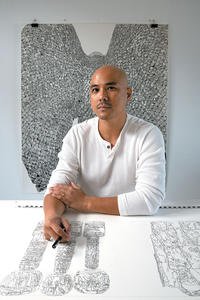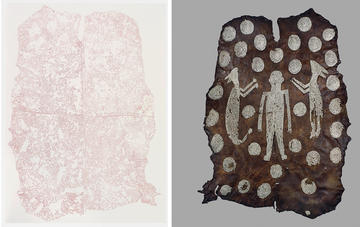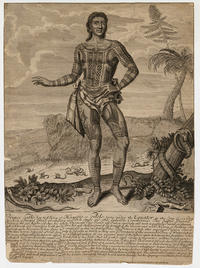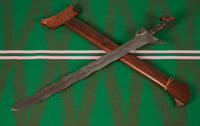ASHMOLEAN NOW EXHIBITION: PIO ABAD – Press release
Launched in the summer of 2023, Ashmolean NOW invites UK-based contemporary artists to create new responses to the Museum’s collections. The latest exhibition in the Ashmolean NOW series will feature profound and challenging original works by the artist Pio Abad (b. 1983).

Abad’s work concerns colonial history and cultural loss and is deeply informed by world history, with a particular focus on the Philippines, where he was born and raised in an academic family who campaigned for justice in the 1970s and 80s during a time of conflict and corruption under the dictatorship of Ferdinand Marcos. Abad’s poetic, personal and political art offers a powerful critique of the way many museums collect, display and interpret the objects they hold and questions prevailing perceptions and perspectives.
Now based in London, Abad has created a wide-ranging body of work for 'To Those Sitting in Darkness' encompassing drawing, sculpture and text. The title is a reference to American writer Mark Twain’s satire ‘To the Person Sitting in Darkness’ (1901), which strongly criticised imperialism.
The exhibition explores, identifies and illuminates objects Abad found in the rich and varied collections of the University of Oxford; his focus on those where their histories have been marginalised, unexplained, ignored or forgotten. His intricately detailed creations are displayed together with other artists’ work alongside ‘diasporic’ objects researched and chosen by Abad from a range of Oxford institutions’ collections and archives, including the Pitt Rivers Museum, St John’s College and Blenheim Palace.

A major piece is the large-sized drawing ‘I am singing a song that can only be born after losing a country’ (2023), based on one of the most important objects in the Ashmolean’s founding collection: ‘Powhatan’s mantle’ (c.1600–1628), a monumental deer-hide hanging with precise shell beadwork ornaments dates to the early 1600s and the first period of contact between Indigenous North American peoples and British colonists. The mantle is named for Wahunsenacawh (c.1550–1618), the chief of the Powhatan people, and also known as the father of Pocahontas.
Using high-resolution photographic scans of the object, Abad has drawn the underside of the mantle to scale. He describes the imaginary map-like work as ‘an atlas for many lands that can never be recovered,’ as a reminder of the erasure of the Native American people that followed the arrival of the British in Wahunsenacawh’s land. Abad links this to the Indian Wars of the 1870s and then to the Philippine-American War, which began in the late 1890s.

Abad was also inspired by a drawing uncovered in the collections at St John’s College of Prince Giolo, a tattooed Filipino slave who was brought to Oxford in the 1680s and exhibited as an exotic curiosity in pubs and other venues. In ‘Giolo’s Lament,’ Abad re-renders Giolo’s tattooed hand through eleven engravings on marble arranged on the gallery’s walls, a moving reminder of his fragile humanity.

At the Pitt Rivers Museum, Abad encountered traditional kris swords from Mindanao (the southern region of the Philippines). The double-edged blades incised with mythic symbols and handles made of precious wood and bone carved in crocodile or bird-like forms were originally owned by Indigenous tribes known as the Moro people, who adapted Islam into their belief system.
These kris swords represent a resistance to colonial rule and conversion to Christianity and speak to historical accounts of dispossession. A selection of these weapons have been resurrected from museum storage for the first time since their accession to be displayed in this exhibition.
Dr Lena Fritsch, Curator of Modern and Contemporary Art at the Ashmolean Museum, said: 'Where many of us who work in or visit museums think of them as spaces of preservation, communication and inclusion, Pio Abad makes the case for them as places of loss, silence and exclusion. His visually alluring and thought-provoking work underlines how art is the ideal medium to rediscover, debate and liberate ‘diasporic’ objects and give them a new cultural platform, memory and voice.'
Dr Xa Sturgis, Director of the Ashmolean Museum, said: 'Ashmolean NOW continues to generate multi-layered, creative and critical conversations between the past and present amongst artists and audiences. This impressive show vividly illustrates the power of engagement with our collections when approached through the lens of the artist’s personal history and perspective.'
ENDS
NOTES TO EDITORS
Exhibition: Ashmolean NOW: Pio Abad – To Those Sitting in Darkness
Dates: 10 February – 8 September 2024
Venue: Gallery 8, Lower Ground Floor, Ashmolean Museum, Oxford, UK
Admission: Free
Catalogue: £20 available from the Ashmolean and at our online shop
PRESS IMAGES & CREDITS
Press Images for editorial use are available to download at: go.glam.ox.ac.uk/pio_abad
FURTHER INFORMATION
Sarah Holland, acting Press and Publicity Manager
sarah.holland@ashmus.ox.ac.uk
press.office@ashmus.ox.ac.uk
T+44 (0)1865 278 178 | www.ashmolean.org/press | @AshmoleanPress
The exhibition is supported by: Ampersand Foundation, Christian Levett, Mercedes U. Zobel, the Patrons of the Ashmolean Museum and those who wish to remain anonymous.
About Ashmolean NOW
Ashmolean NOW launched in 2023 to engage and support new artistic voices based in the UK and encourage critical conversations with, and creative responses to, the Ashmolean’s collections. Ashmolean NOW is curated by Dr Lena Fritsch, Curator of Modern and Contemporary Art, and presented in Gallery 8. To date, Ashmolean NOW has invited four very different artists and perspectives to exhibit:
Flora Yukhnovich x Daniel Crews-Chubb (8 July 2023 – 14 January 2024); Pio Abad (10 February – 8 September 2024); Bettina von Zwehl (from October 2024).
ABOUT THE ARTIST
Pio Abad’s artistic practice is concerned with the personal and political entanglements of objects. His wide-ranging body of work, encompassing drawing, painting, textiles, installation and text, mines alternative or repressed historical events and offers counternarratives that draw out threads of complicity between incidents, ideologies and people. Deeply informed by unfolding events in the Philippines, where Abad was born and raised, his art emanates from a family narrative woven into the nation’s story. Abad’s parents were at the forefront of the anti-dictatorship struggle in the Philippines during the 1970s and 80s and it is the need to remember this history that has shaped the foundations of his work.
pioabad.com
Press Release Images:
Banner image: Pio Abad (b.1983) 'Giolo’s Lament' (detail), 2023
(One of eleven engravings on marble)
© Pio Abad. Courtesy the artist
Pio Abad in his studio
Courtesy the artist
John Savage (active 1683–1700)
Portrait of Prince Giolo, Son of King Moangis, 1692
© St John’s College, Oxford
Pio Abad (b.1983) 'I am singing a song that can only be borne after losing a country', 2023
© Pio Abad. Courtesy the artist
Powhatan's Mantle, c.1600–1628
Presented by Elias Ashmole, 1677, from the Tradescant Collection
© Ashmolean, University of Oxford
A kris sword from the Philippines, donated in 1911
© Pitt Rivers Museum, University of Oxford




